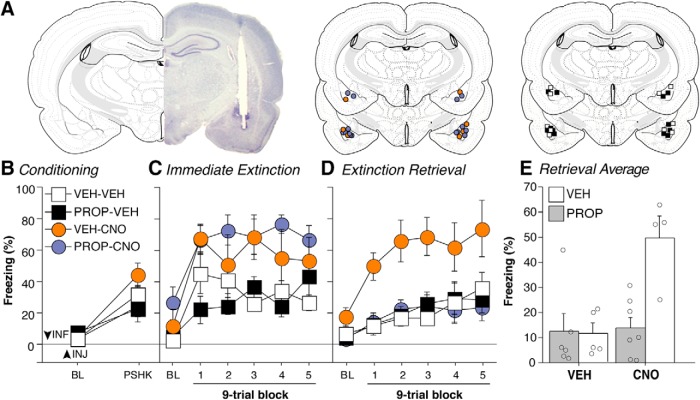Figure 5.
Intra-BLA propranolol blocks LC-NE-induced extinction deficits. Rats expressing hM3Dq in the LC received intra-BLA infusions of VEH or PROP approximately 20 min prior to fear conditioning. The rats were then systemically injected with VEH or CNO 10 min prior to conditioning (VEH-VEH, n = 5; PROP-VEH, n = 6; VEH-CNO, n = 4; and PROP-CNO, n = 7). A, Representative and schematic histology of BLA cannula placements. B, All groups conditioned similarly as evidenced by an increase in freezing behavior following footshocks. C, Animals underwent immediate extinction in a new context 15–20 min after conditioning. Rats treated with CNO showed elevated freezing relative to vehicle controls and this was not reduced by intra-BLA propranolol. D, Animals underwent an identical extinction retrieval session 48 hrs after extinction in a drug-free state. Rats that received systemic injections of CNO and intra-BLA VEH infusions showed elevated freezing throughout this session, replicating our prior finding (i.e., LC-NE activation induces an immediate extinction deficit when paired with a weak shock). Intra-BLA PROP reduced freezing during this session similar to rats treated with systemic VEH and either intra-BLA VEH or PROP, suggesting that intra-BLA PROP mitigates LC-induced extinction deficits. E, The retrieval data are summarized in panel E, which shows the average freezing for the first 9-trial block split by group. Rats that were administered systemic VEH and either intra-BLA VEH or PROP showed minimal freezing, suggesting that this protocol is not sufficient to induce an IED. Rats treated with systemic CNO alongside intra-BLA VEH displayed elevated freezing levels, indicative of an IED and this was blocked by intra-BLA PROP. Open circles represent data from individual subjects. Percentage of freezing (mean ± SEM) is shown for all sessions.

